CONTENTS
Quantum’s Go-to-Market Strategy Playbook Introduction.............................................. 4
What is a Go-to-Market Strategy?.................................................................................... 5
The Quantum Growth Model.............................................................................................. 6
The Funnel GTM Strategy....................................................................................................8
Understand the Buyer’s Journey........................................................................................ 9
The 5 Steps to Get the Flywheel Spinning...................................................................... 10
Step 1: Assess.................................................................................................................... 11
What are the assessment steps to build your Go-to-Market Strategy?....................... 11
Market Analysis.................................................................................................................. 12
Benchmark Your KPIs........................................................................................................ 13
Define Your Business Goals.............................................................................................. 14
Identify Your Ideal Client Profile (ICP) and Target Market............................................. 15
Buyer Personas.................................................................................................................. 16
Value Matrix........................................................................................................................ 17
Multiple Stakeholders........................................................................................................ 18
Assess Your Current “Tech Stack”................................................................................... 19
Assess All Current Assets................................................................................................ 20
Understand Current Investments and Output................................................................ 20
Game Plan with Quantum’s RevEfficiency Model........................................................... 21
Step 2: Systemize............................................................................................................. 23
Building Your Marketing Plan........................................................................................... 24
Create a Messaging Strategy.......................................................................................... 25
Right Messaging at the Right Time to the Right Audience........................................... 26
What Your Buyer is Thinking at Each Stage................................................................................................................................. 27
Marketing Segmentation Template................................................................................ 28
Content Outline................................................................................................................ 29
Map Your Buyer’s Journey................................................................................................ 31
Build Your Content Library............................................................................................... 32
Develop a Pricing Strategy............................................................................................... 33
Enrich Your Database....................................................................................................... 34
Segment Your Database................................................................................................... 35
Building Your Sales Plan................................................................................................... 36
Define Sales Goals & Objectives......................................................................................37
Develop Your Unique Selling Proposition....................................................................... 39
Mapping Your Sales Process........................................................................................... 41
Target Audience................................................................................................................ 43
Sales Messaging............................................................................................................... 44
Lead Scoring.................................................................................................................... 45
Customer Service Plan.................................................................................................... 46
Step 3: Optimize.............................................................................................................. 47
KPIs for Optimization........................................................................................................ 48
Building and Managing Lists............................................................................................. 51
Nurturing Leads Who Haven’t Converted Yet................................................................ 52
Building Workflows............................................................................................................ 53
Pipeline Management....................................................................................................... 55
Pipeline Management in HubSpot................................................................................... 55
Maximizing Free Billboard Space..................................................................................... 57
Content Optimization........................................................................................................ 59
Step 4: Automate............................................................................................................... 61
Target..................................................................................................................................64
Attract.................................................................................................................................65
Nurture............................................................................................................................... 68
Convert.............................................................................................................................. 70
Wow.................................................................................................................................... 71
Other.................................................................................................................................. 72
Step 5: Execute & Improve............................................................................................... 74
CAC & ROI.......................................................................................................................... 75
A/B Testing......................................................................................................................... 76
Maintain Email Health....................................................................................................... 77
Manage Sales & Marketing Alignment............................................................................ 77
Retain & WOW Your Customers....................................................................................... 78
Renewals, Cross-Sell, Upsell & Referrals........................................................................ 79
Refine As Needed............................................................................................................. 80
Introduction
Quantum’s Go-to-Market Playbook is a reference and workbook guide for sales, marketing, and execution. The goal of this playbook is to provide a framework for how your company will bring its products or services to market.
A GTM strategy for distribution, communication, and sales efforts can help your company better reach your target. The goal of the GTM strategy is to ensure the most effective and efficient use of resources to drive revenue growth.
The GTM plan must be constantly evaluated and adjusted to ensure that it is effective. Marketing and sales campaigns need to be timed correctly and budgets need to be allocated efficiently. If any part of the plan is not working, it needs to be changed to achieve the desired results. This will require careful monitoring of key performance indicators (KPIs), as well as a constant evaluation of how they are impacting business goals.
We have developed Quantum’s Go-to-Market Playbook as a living document that can be customized for your organization and should be constantly evaluated and adjusted. Marketing and sales teams need to be agile and able to adapt to changes in the market to be successful. By constantly adjusting and evaluating your GTM plan, your business can ensure that you are taking the most effective steps possible to reach your target audience and achieve your goals.
What is a GTM strategy?
A GTM strategy is a plan for managing and executing marketing activities across different channels. It helps to ensure that all marketing efforts are aligned and working towards the same goal. A GTM strategy should include a detailed plan for each stage of the buying process, as well as specific goals and objectives for each channel.
An effective GTM strategy must have alignment between sales and marketing to ensure that the right message is being delivered to the right audience. If there is a disconnect between the two teams, it can lead to confusion among customers and decreased sales. Marketing needs to understand what Sales is looking for in potential customers and how best to reach them, while Sales needs to understand what marketing is doing to attract leads and how those leads can be converted into customers. By working together, both teams can create a well-coordinated strategy that will result in more successful sales outcomes.
The science of sales and marketing is all about perfecting the tactical elements so that you can focus on what really matters: building those lasting client relationships. By understanding the principles of effective selling and marketing, you can create a strategy that will work for your business. Tactics such as creating a strong offer, targeting the right audience, and using the proper channels are essential to success.
However, it's also important to understand buying and selling psychology. People are not always rational in their decisions, and it's important to consider their emotional needs as well. The best sales and marketing strategies take both science and art into account and strive to create a balance between the two. When done correctly, this balanced approach can help you achieve great results for your business.

Quantum Growth Model
The Quantum Growth Model is designed as a flywheel. A flywheel sales and marketing process is a cyclical process that helps to build momentum and increase sales. The process begins with generating leads and ends with happy customers. In the middle, there are several stages including attracting and qualifying leads, nurturing relationships, and selling relevant products or services to convert leads into customers.
The flywheel process helps to keep the sales and marketing activities in sync and moving forward. The flywheel principle is based on the idea that sales and marketing efforts should be consistent and sustained to generate results over time. It's a metaphor for how a flywheel works: you need to keep pushing on it to get it going, but once it's in motion, it keeps spinning on its own.
In terms of sales and marketing, this means that you need to continuously put in the effort to get new leads and customers, but once you have them, you should continue to market to them to keep them engaged. This process can be slow and incremental, but it ultimately builds momentum and delivers long-term results.
If done correctly, your existing customers will become a key component of driving new business and accelerating the flywheel. These customers who you wowed by sending them the right messages at the right time, nurturing, and educating them on the benefits of your products and services, and who are satisfied with the results are primed for cross-selling and upsell opportunities. These customers can literally become an extension of your sales team by generating referrals for new customers for your business. You now have a solid foundation to build upon to create an even more successful business.

The Funnel GTM Strategy
In the following pages, we will discuss a funnel GTM strategy. The funnel GTM strategy is used to attract leads and nurture them into sales. By understanding your customer’s needs and desires at each stage, you can create targeted content that will move them through the funnel and closer to a sale.
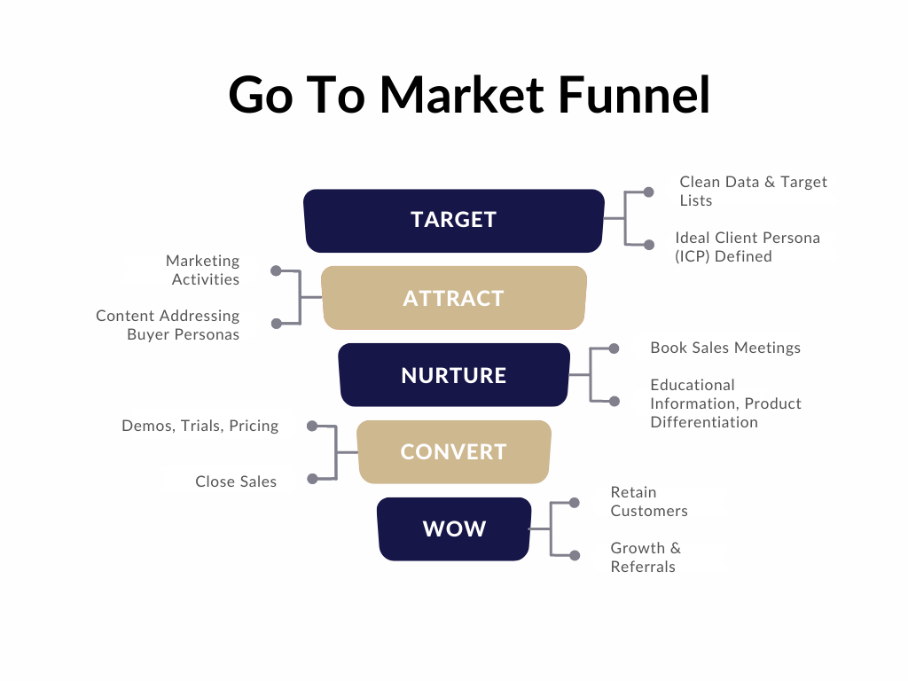
Understand the Buyer’s Journey
The decision-making process starts with awareness and continues to unfold in a series of steps. The first step is when people become aware that you're selling something, usually through an advertisement or marketing campaign which makes them curious about what's being offered; this could lead someone who wasn't interested before looking into your products/services further once they've found out more information on the company website (or social media). It's important to know that at each stage of the buying process, you need to have more information available about your products and services. This allows buyers to become aware not only of what is being offered but also of how valuable it could be for them.
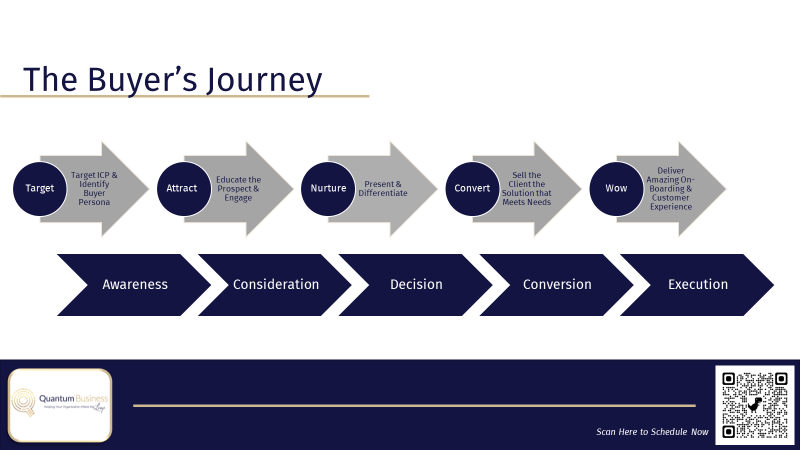
The 5 Steps to Get the Flywheel Spinning
Quantum's team of experts will help you define your business needs and objectives, identify your key stakeholders, and create a plan for building and executing your GTM strategy. Our team will work closely with you to ensure that your GTM strategy meets your unique business needs. Following Quantum's GTM Playbook will help you to improve your results by creating and executing a plan that incorporates the following 5 steps: Assess, Systemize, Optimize, Automate, and Execute and Improve.
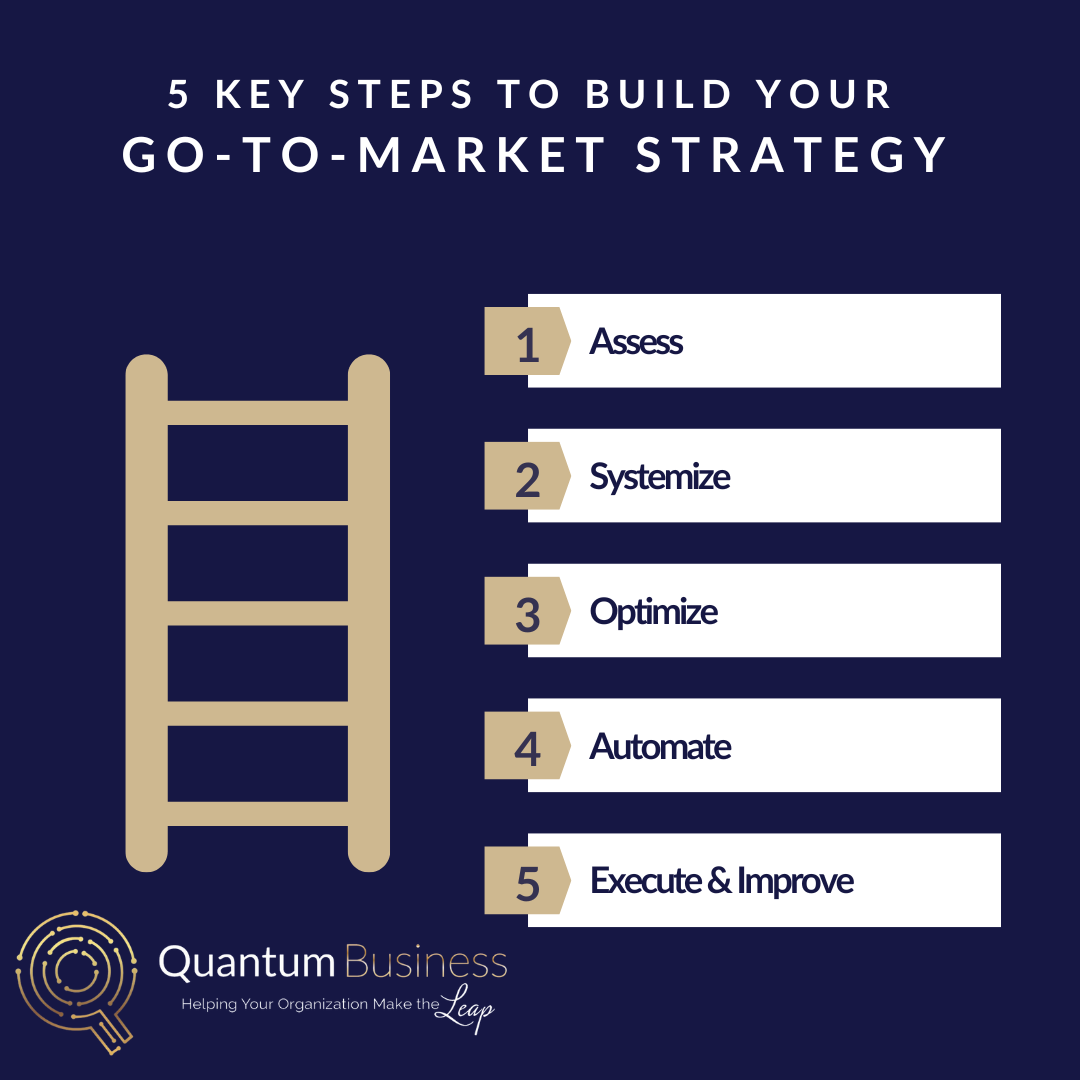
Step 1: Assess
An assessment is a key part of any GTM strategy. It’s important to take the time to understand your target market. Who are they? What do they want? What are their needs? If you don’t know who your target market is, you won’t be able to reach them with your product or service. The goal of any good GTM strategy is to identify a market problem and position your product as the solution.
Your assessment should also include an analysis of your competition. What do they offer? How do their products or services compare to yours? What are their strengths and weaknesses? Understanding your competition is essential if you want to be successful. You need to know what you’re up against and how to beat them.
Once you have all this information, you can start creating a strategy for how to reach your target market. You need to know where to find them, how to reach them, and what kind of message will resonate with them.
Creating a well-informed assessment is essential for any successful GTM strategy. It will help you understand your target market, your competition, and how to reach your customers.
Market Analysis
The process of finding product-market fit starts with answering the question, "What problem does your company solve?" You can then identify who's going to be using that solution and how much they're willing to pay for it
Complete the Market Analysis and SWOT exercises in the GMT Workbook.
Define Your Business Goals
When crafting a GTM strategy, it's essential to define what you are trying to accomplish. Generally, there are three main goals that a company might have when entering the market:
1. Grow market share - To grow market share, companies need to identify their target markets and then develop strategies to reach those markets. This may involve expanding into new geographic areas or targeting new customer segments.
2. Penetrate new markets - To penetrate new markets, companies need to identify where their potential customers are and then develop strategies to reach them. This may involve launching products and services in new geographies or targeting new customer segments.
3. Increase revenue - Companies need to identify their current and potential customers and then develop strategies to reach them. This may involve launching new products and services, increasing prices, or expanding into new geographic areas.
It is important to define each of your business goals for your go-to-market strategy. Remember, each goal should be SMART: Specific, Measurable, Achievable, Relevant, and Time-bound. Here are a few examples of business goals that you could set for your go-to-market strategy:
1. Increase market share by 10% in the next 12 months.
2. Earn $100,000 in new revenue in the next 6 months.
3. Garner 500 new leads in the next 60 days.
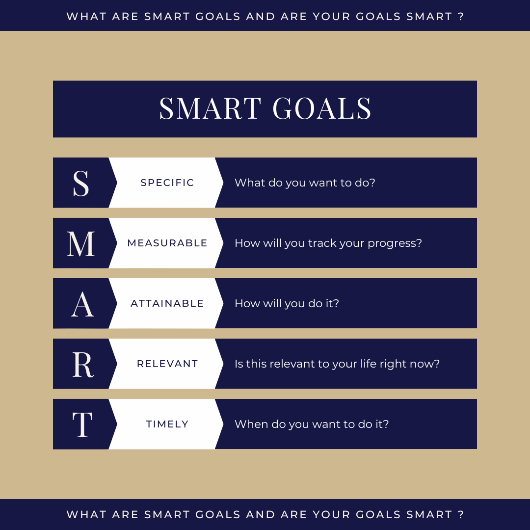
Benchmark Your KPIs
Benchmarking your key performance indicators (KPIs) is one of the most important things you can do as a business owner or manager. By comparing your KPIs against those of your competitors, you can identify areas where you are performing well and areas where you need to improve. This information can help you make strategic decisions about your business that will help you stay ahead of the competition.
Benchmarking can also help you track your progress over time. By comparing your current results against past performance, you can see how well your efforts are paying off and make necessary adjustments. Additionally, benchmarking can help you identify potential new markets or opportunities for growth.
Overall, benchmarking is a valuable tool for improving your business performance. It can help you identify strengths and weaknesses, track progress, and make informed decisions about the future of your company.
If you do not already have automated dashboard reporting, we will begin by tracking your KPIs on a spreadsheet.
Answer the questions in the workbook.
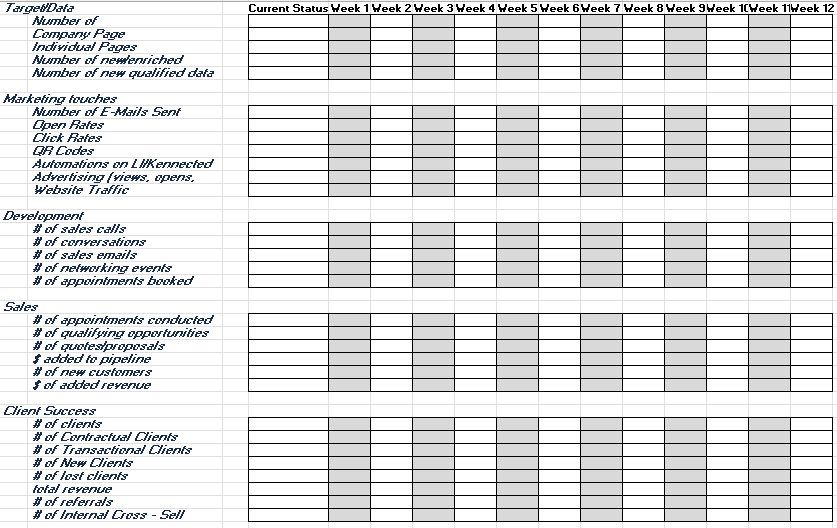
Identify Your Ideal Client Profile (ICP) and Target Market
Your ICP should be interested in what your company does and is a potential customer. They should also be within your target market, which is the group of people that you want to reach with your GTM strategy. Your ideal client profile should be likely to buy your product or service, and someone who you can reach with your marketing efforts.
An ICP can help you identify the perfect customer for your business. Refer to this HubSpot blog article for help with defining your ICP.
Here is An Example:
An ideal client profile for a copier dealership that also provides IT managed services would be a company with between 50 and 500 employees. The company would have a limited or no in-house IT staff and would need to outsource all or most of their IT needs. The company would also need to have a reliable and consistent copier and printer fleet, as well as a need for new equipment on a regular basis. They would also need to be within driving distance of the dealership to make service appointments easy. The business should also have a budget that allows for regular maintenance and repairs.
Remember to define the geographic parameters of your target market. It's important to know what area the business will serve to properly market and advertise to potential customers. The parameters of the target market can help businesses focus their efforts and resources on a specific area, making it more likely that they will be successful.
Complete the activity in the workbook.
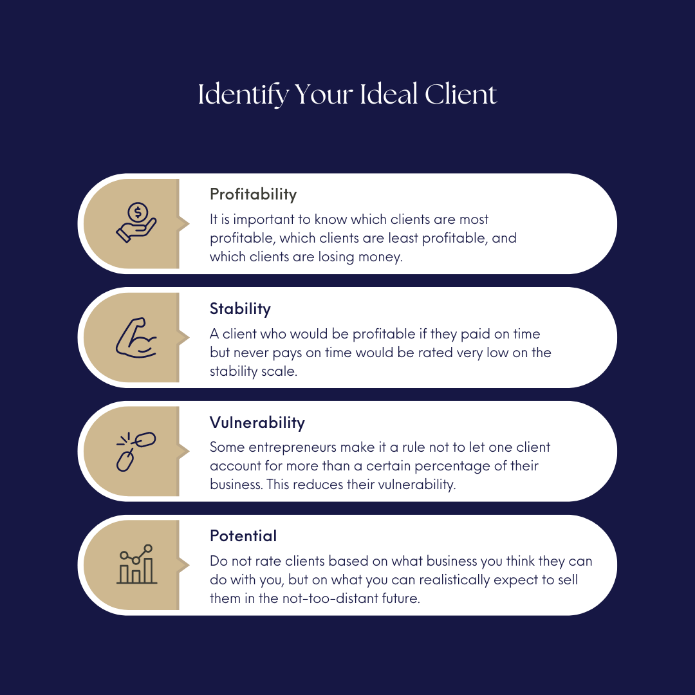
Buyer Personas
A buyer persona is a fictional representation of your ideal customer. It is a composite character created from market research and real data about your customers. Your buyer personas will help you to better understand your target market and to create content, products, and services that appeal to them.
You will have more than one buyer persona, to better target different segments of your customer base. For example, a business that sells luxury watches might create one persona for young executives who are looking to show off their wealth and status, and another persona for older, more established professionals who are looking for a reliable timepiece to wear day-in and day-out. By understanding the needs and wants of your target customers, your business can create content and products that speak directly to them.
You can utilize HubSpot’s Make My Persona tool to identify and define your buyer personas. Each of your personas will have a name such as Founder Fred, IT Ian, or Marketing Manager Mary. Buyer personas are a tool that can help you focus your time on qualified prospects, guide product development to suit the needs of your target customers, and align all work across organizations from marketing to sales or service.
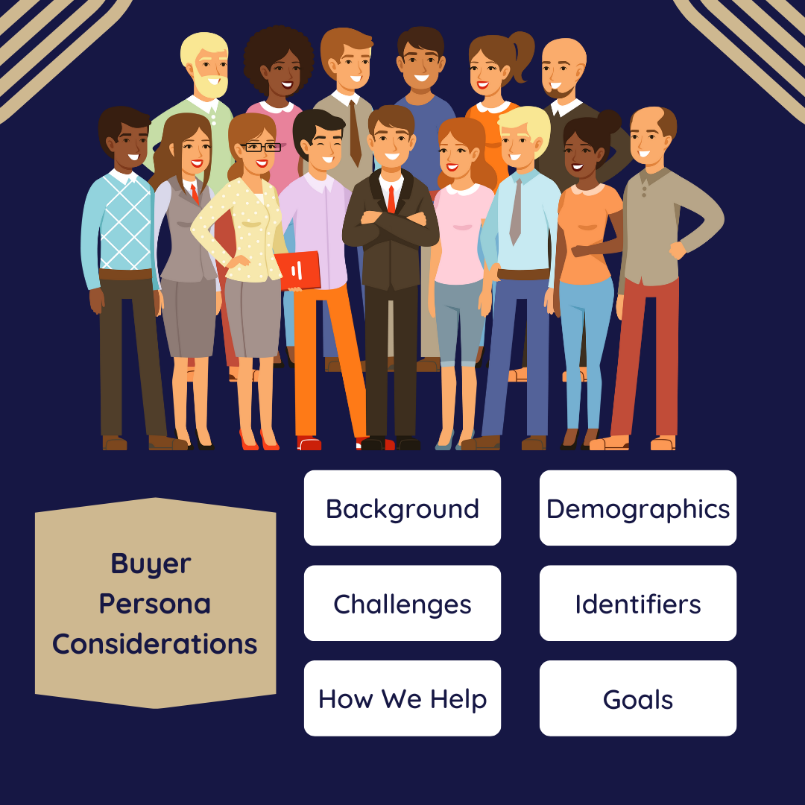
Craft a value matrix for each buyer persona to help identify key messaging. Understand what has worked and what has not.
Complete the Value Matrix in the workbook.
Multiple Stakeholders
According to Gartner, the typical buying group for a complex B2B solution involves six to 10 decision-makers. These roles may, but may include:
Initiator: Makes initial inquiry
End User: The user of the product or service
Influencer: Can persuade or convince others to buy your product or service
Decision maker: Gives final approval for the purchase
Budget Holder: Owns the budget
Vendor Manager: Maintains relationships, negotiates contracts, and ensures that deliveries are made on time and according to specifications
Buyer: Purchases the product or service
Gatekeeper: Controls access, usually to key decision-makers
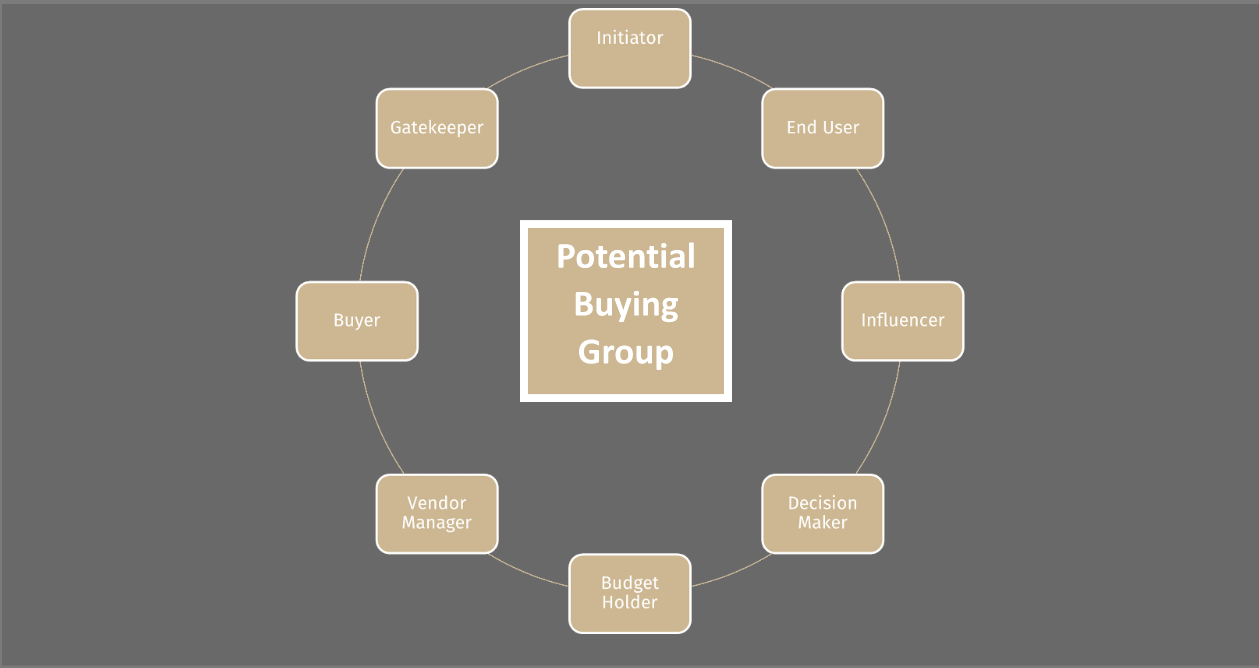
*These roles vary based on the product, industry, and vertical you’re selling to. Get your team together and brainstorm the various job titles that could be impacted by your solution.
Assess Your Current “Tech Stack”
With the dizzying array of technologies available, it can be difficult to find solutions that integrate with other systems and automate the tasks. A well-integrated tech stack is important for a GTM strategy because it allows businesses to deploy and manage sales and marketing efforts quickly and easily. By having a unified platform, businesses can more easily track data and performance indicators, which can help them make better decisions about where to allocate resources to achieve the best results. Additionally, a well-integrated tech stack can improve communication between departments, resulting in a more streamlined and cohesive overall strategy.
An example of a tech stack that we might recommend could incorporate a combination of the programs below:
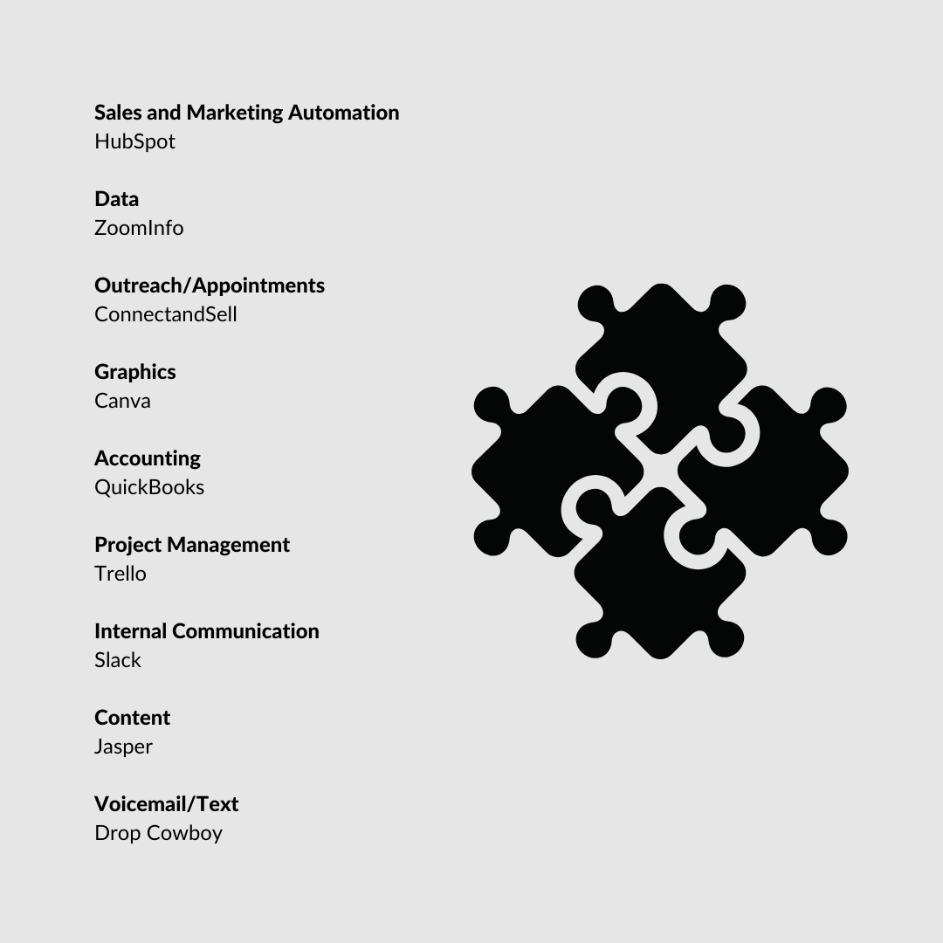
Now complete the activity in the workbook.
Assess All Current Assets
One important step in developing your GTM strategy is understanding what assets you already have at your disposal and assessing whether they are relevant to your new strategy. This includes looking at your current website and marketing materials, as well as your customer data. You should also consider any partnerships or other alliances you may have that could be beneficial to promoting your new GTM strategy. By taking all these factors into account, you can develop a plan that makes the most of your current resources while also expanding your reach to new customers. Make a list to identify what is still relevant, what needs to be updated, and what needs to be scrapped.
Understand Current Investments and Output
It is important to understand current investments and outputs in the following areas when assessing your GTM strategy:
- Current Marketing or Sales Plans
- Data Enrichment Sources and Quality of Data
- Current organizational structure
- Largest Growth Opportunities
Marketing plans can include things like website redesigns, content marketing campaigns, or even just tweaks to the email marketing program. Sales plans can include changes to the sales process, hiring new reps, or revising commission structures.
Data enrichment sources can be internal (such as customer data from the CRM) or external (such as social media data). Quality is important for two reasons: first, you want to make sure you're getting accurate data to work with; second, you don't want to overload your team with data that's difficult to act on.
The organizational structure will dictate how decisions are made within the company and who has final authority on GTM decisions. The largest growth opportunities are usually the ones that are most obvious - but they're also usually the ones that have been most heavily pursued by competitors.
Game Plan with Quantum’s RevEfficiency Model
The RevEfficiency Model is designed to focus first on the revenue closest to you first and then expand out from there. Start with your existing customers to increase revenue opportunities. First and foremost, WOW and retain your existing customers. Evaluate all cross-sell and upsell opportunities. You should also leverage your existing customer base to provide you with referrals and maximize revenue potential with that group. Look at how those customers who are happy and have relationships with you can benefit your business. Then, branch out until you begin going after net new business. These are the coldest and usually hardest leads to convert, but it's important to grow your business in all directions. Keep your current customers.
- 1.Retain your current customers by building and nurturing the right relationships.
- 2.Grow your current customer base through upselling and cross-selling.
- 3.Multiply with similar and like-minded customers through referrals and affiliate programs.
- 4.Convert opportunities to closed deals.
- 5.Expand and go after net new business.

Complete the questions in the workbook.

Step 2: Systemize
Systemizing in a GTM strategy is the process of developing a repeatable process for launching and scaling your product or service, setting up the necessary infrastructure, and building a team to support your efforts. This includes creating a plan for marketing, sales, customer service, and operations. It's important to have a systemized approach so that you can efficiently roll out your product and grow your business.
One key step in systemizing your go-to-market strategy is creating a marketing plan. Your marketing plan should outline your overall marketing strategy and how you will reach your target audience. It should also include detailed tactics such as which channels you will use, what content you will create, and what budget you have allocated.
Another important step is creating a sales plan. Your sales plan should identify your target market, outline your sales process, and identify your key selling points. It's also important to allocate enough resources to support your sales efforts, such as hiring a sales team or investing in CRM software. One of the most important steps in systemizing your go-to-market strategy is creating a sales playbook. This document will outline how you plan to sell your product or service, including the steps involved in each sale, the typical objections you'll face, and how to overcome them.
Finally, it's important to have a well-defined customer service plan. Your customer service plan should outline your customer support strategy, including how you will address customer complaints and resolve issues. It's also important to have processes in place for training your customer service team and tracking customer satisfaction levels.
Once you have a solid plan in place, it's important to track your progress and make course corrections as needed. Use analytics to measure key performance indicators (KPIs) like website traffic, lead conversion rates, and customer churn rates. This information will help you determine whether your strategy is working and identify areas that need improvement.
Building Your Marketing Plan
Building your marketing plan for your GTM strategy will include the following steps:
- Create a messaging strategy
- Right messaging at the right time to the right audience
- Understand what your buyer is thinking at each stage
- Marketing segmentation template
- Content outline
- Map your Buyer’s Journey
- Build your content library
- Develop a pricing strategy
- Enrich your database (ZoomInfo)
- Segment your database by buyer persona and product or service for each stage of the buyer’s journey
Create a Messaging Strategy
One key element of a successful GTM strategy is messaging. Messaging is how you communicate the value of your product or service to your target market. It's essential to develop a clear and consistent messaging strategy that will resonate with your target audience.
There are several factors to consider when crafting your messaging strategy. First, you need to understand your target market and what motivates them. What are their needs and wants? What are they afraid of? What keeps them up at night? Once you have a good understanding of your target market, you can start creating messages that speak to their needs and concerns.
It's also important to be aware of your competition and how they're messaging their products or services. What are they saying that's resonating with customers? Can you offer something more? Can you offer it at a better price?
Your messaging should also be consistent with your brand identity. Everything from your logo to your website copy should reflect the same message. The tone of your marketing materials should also be consistent - whether you're targeting consumers or businesses.
Finally, it's important to test and tweak your messaging until it's working well for you. Try out different headlines, call-to-action buttons, etc. and see what generates the most response from your target audience. Keep track of what works and what doesn't and make changes as needed.
Crafting an effective messaging strategy can be challenging, but it's essential for any successful GTM plan. By understanding your target market, speaking to their needs and desires, and being consistent with your branding and tone, you can create a powerful messaging strategy that will help you achieve success in any market.
Right Messaging at the Right Time to the Right Audience
It is also critical to send the right message at the right time to the right audience. Depending on where leads are in the funnel, the messaging and what is included should be different. If you are targeting people who are not familiar with your product, you will need to focus on building awareness and introducing them to your company and what it does. Once they have expressed some interest in your product, you can start focusing on getting them to take the next step by providing more detailed information. Finally, for customers who have already decided to buy from you, make sure you are providing enough value after the sale to keep them happy and coming back for more.
ToFu: The Top of Funnel is where you first introduce your product or service to a prospect.
MoFu: The Middle of Funnel is where you provide more information to a prospect about your product or service.
BoFu: The Bottom of Funnel is where you close the sale with a prospect.
Using these terms can help you track where potential buyers are in the buying process and adjust your marketing strategy accordingly.
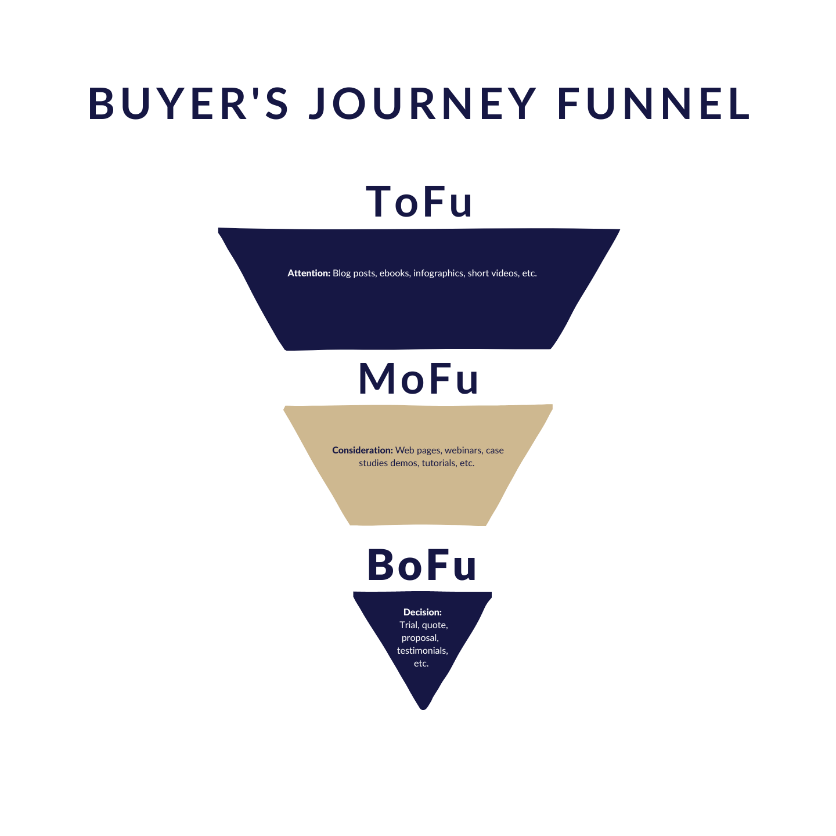
What Your Buyer is Thinking at Each Stage
ToFu: When you are first introduced to a new product or service, the most important thing is that you understand what it is. So, make sure you are clear and concise in explaining what your product or service is.
MoFu: After explaining what your product or service is, the next most important thing is how it can help your buyer. Explain how it will help them solve their problem or make their life easier in some way.
BoFu: Finally, explain how buyers can start using your product or service. Show them where they can find more information or give them a step-by-step guide on how to get started.
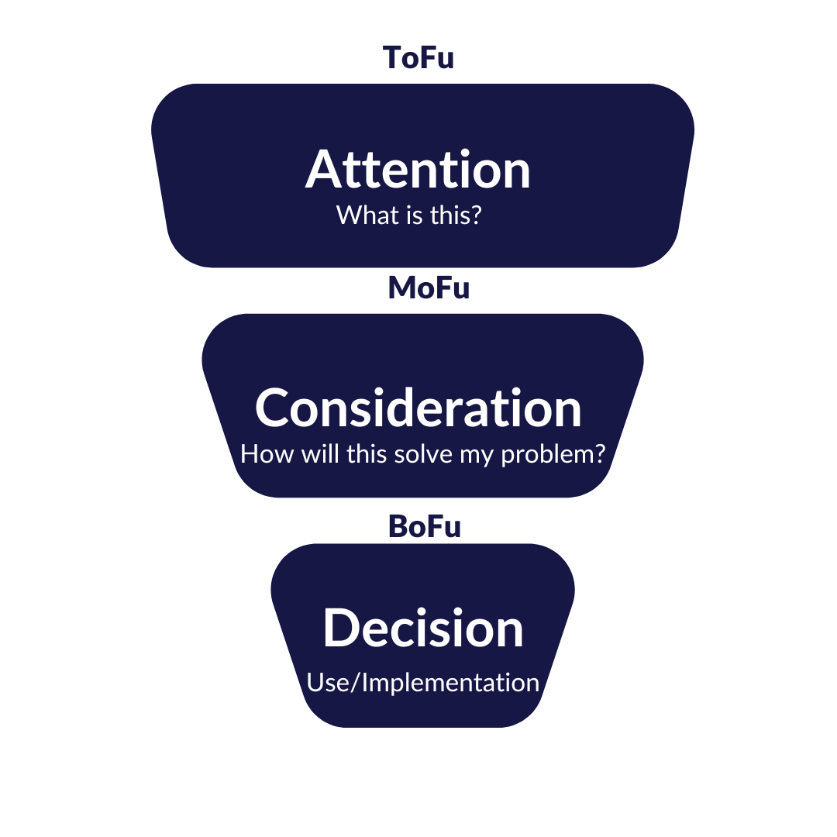
Map Your Buyer’s Journey
The Buyer's Journey is important to understand because it can help you improve your marketing strategy. By mapping out the steps of the journey, you can better understand where your potential customers are in the process and what you can do to help them move closer to making a purchase. You may also find that some stages are more important than others when it comes to converting leads into customers.

Next, complete the Marketing Segmentation Template and the Content Outline template in the workbook.
Build Your Content Library
Once you have a rough outline of what is needed for your content library, it's time to start creating it! If you don't have the time or resources to create all the content yourself, consider partnering with a content marketing agency or freelance writer to help you out. Quantum provides some of these services as well.
Your content library should be housed and updated in a central location, such as HubSpot. This will make it easy for your team to access and share content with each other and will help you track which pieces are performing the best. You can use HubSpot's built-in analytics to track how much traffic each piece of content is generating, how many leads it's generating, and how much engagement it's getting. This information can help you determine which pieces of content are worth investing more time and resources into, and which ones you might want to retire.
Develop a Pricing Strategy
Developing a pricing strategy can be difficult, but there are some key things to keep in mind. One important factor is understanding what the competition is doing. It's important to be aware of what the competition is charging for their products, as well as what discounts they may be offering.
Another key factor is understanding your target market. Who are you selling to, and what do they value? What is the maximum amount they would be willing to pay for your product? It's also important to consider what your production costs are, and whether you're able to lower them without sacrificing quality.
Once you have a good understanding of all these factors, you can start developing a pricing strategy. It's important to experiment with different pricing strategies and see what works best for your business. There's no one-size-fits-all answer when it comes to pricing, so it's important to find a strategy that works for you and your products.
Below are 6 pricing strategies for your consideration.
1. Value-based pricing: Charging based on the perceived value of the product or service to the customer. This can be difficult to determine, as it varies from customer to customer.
2. Competitive pricing: Setting prices at or near those of competitors to attract customers.
3. Price skimming: Charging a high price for a new product or service to recoup development costs, then lowering the price as demand increases.
4. Cost-plus pricing: Adding a markup to the cost of producing the product or service to generate a profit.
5. Penetration pricing: Charging a low price to increase market share and eventually raise prices.
6. Economy pricing: Offering products and services at a lower price to attract more customers.
Enrich Your Database
To have an effective marketing strategy, it is important to have clean data. Too many organizations operate with outdated contact data. It is important to continually enrich your data with a tool like ZoomInfo that can be easily integrated with HubSpot and other technologies in your tech stack.
ZoomInfo’s comprehensive B2B database can help you keep your contact information up to date. With their easy-to-use interface, you can quickly integrate enriched data into your HubSpot account. This will help you to keep your data clean and accurate so that you can send the most relevant and effective marketing messages to your contacts.
In today’s digital age, it is more important than ever to have accurate contact information. With ZoomInfo, you can keep your data up-to-date and ensure that your marketing messages reach the right people.
Segment Your Database
Creating custom properties and tracking relevant data about the leads in your CRM is key to successfully targeting your different buyer personas at different stages in the Buyer's Journey. By doing this, you can ensure that your messaging is relevant and resonates with each individual persona.
For example, if you are targeting a company's CEO, you will want to make sure that you have the appropriate buyer persona property tagged, such as "CEO Charlie" in your CRM. If this CEO also showed intent for a particular product or service, you would want to make sure there is a custom property created that indicates this CEO is a prospect for Product A. This will allow you to specifically target this persona with messaging that is relevant to their role within the company, as well as relevant product offerings.
It is also important to consider the stage of the Buyer's Journey that each persona is in. For example, someone who is in the Awareness stage may not be interested in reading about your product's features and benefits but may be more interested in learning about your company's history or how you solve problems for your customers.
By taking all these things into account, you can create a tailored marketing strategy that resonates with each individual buyer persona and helps you to close more sales.
You will want to carefully consider what data you need to track to be able to properly segment your audience.
Building Your Sales Plan
Once the lead displays a high level of engagement, they will transition from marketing messaging to interacting with your sales team. A well-defined sales process that includes triggers and tasks to convert the customer will give you a competitive edge in today's market. Upon completion of your sales plan, the materials you have created should be compiled to complete your Sales Playbook.
Building your sales plan for your GTM strategy will include the following steps:
- Define sales goals and objectives
- Develop your unique selling proposition (USP)
- Map your sales process
- Define your target audiences
- Develop sales messaging
- Score your leads
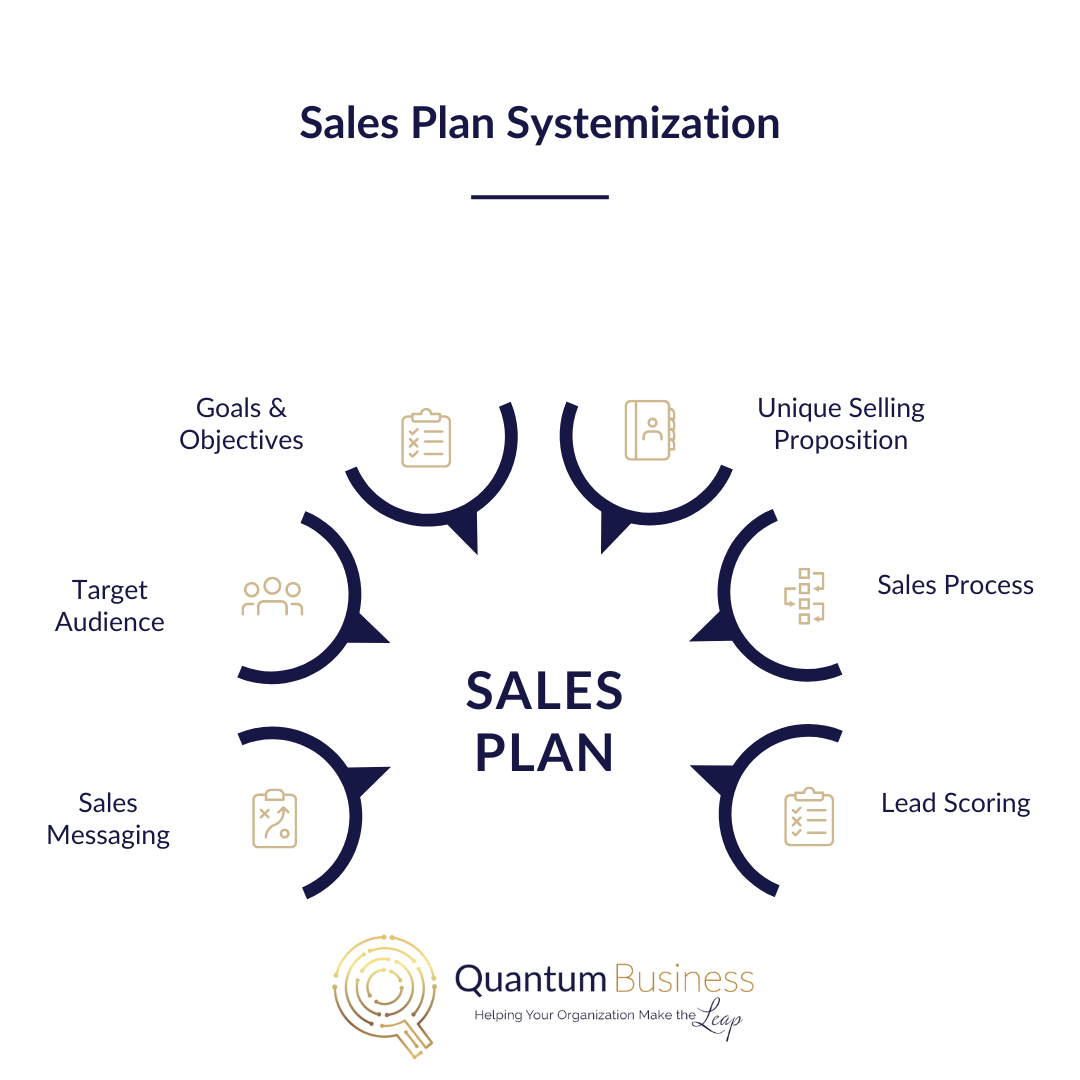
Define Sales Goals & Objectives
Before you can set any sales goals or objectives, it's important to know your company's overall strategy and what you're trying to achieve. Your GTM strategy will be specific to sales goals, so it's important to have a good understanding of what you want to achieve.
Fill in your SMART sales goals and objectives on the chart on the workbook and answer the questions.
Develop Your Unique Selling Proposition
Your Unique Selling Proposition (USP) is key to a successful GTM strategy. It differentiates your product or service from your competitors and tells potential customers what makes you stand out. Crafting a strong USP can be tricky but following these tips will help you create one that will resonate with your target market.
- 1.Start by defining what your product or service is and what problem it solves. This should be at the core of your USP.
- 2.Next, think about the unique benefits your product or service offers. What sets it apart from the competition?
- 3.Make sure your USP is memorable. It needs to be something that potential customers will remember and associate with your product or service.
- 4.Keep it simple. Your USP should be easy to understand and communicate.
- 5.Be clear about who your target market is and what needs they have that your product or service can address.
- 6.Once you have a strong USP in place, make sure to communicate it effectively to potential customers. This means using the right language and messaging that resonates with them. Having a clear and concise message will help you stand out from the competition and attract more customers to your business.

Examples
Company: Canva
Customer Pain Point: Expensive and complicated design software programs
USP: “Empowering the world to design”
Company: Nike
Customer Pain Point: Access to athlete-level quality athletic gear
USP: “Bring inspiration and innovation to every athlete in the world. If you have a body, you are an athlete.”
Company: Robinhood
Customer Pain Point: Investing is complicated, and it takes money to get started.
USP: “Investing for everyone”
Company: FedEx
Customer Pain Point: Fast delivery option
USP: “When it absolutely, positively, has to be there overnight.”
Mapping Your Sales Process
Mapping your sales process is one of the best things you can do for your business. When you map your sales process, you can see where your business is weakest and where you need to make improvements. Additionally, mapping your sales process helps you to identify areas where you can improve customer satisfaction and increase sales.
One of the biggest benefits of mapping your sales process is that it helps you to track progress. When you map your sales process, you create a roadmap for success. This roadmap helps you to track your progress and make changes as needed. Additionally, when you track your progress, you can see how effective your changes have been and make further adjustments as needed.
Another benefit of mapping your sales process is that it enables you to measure efficiency. When you map your sales process, you can identify bottlenecks and inefficiencies. This information allows you to make changes that improve the efficiency of your sales process. Furthermore, by improving the efficiency of your sales process, you can save time and money.
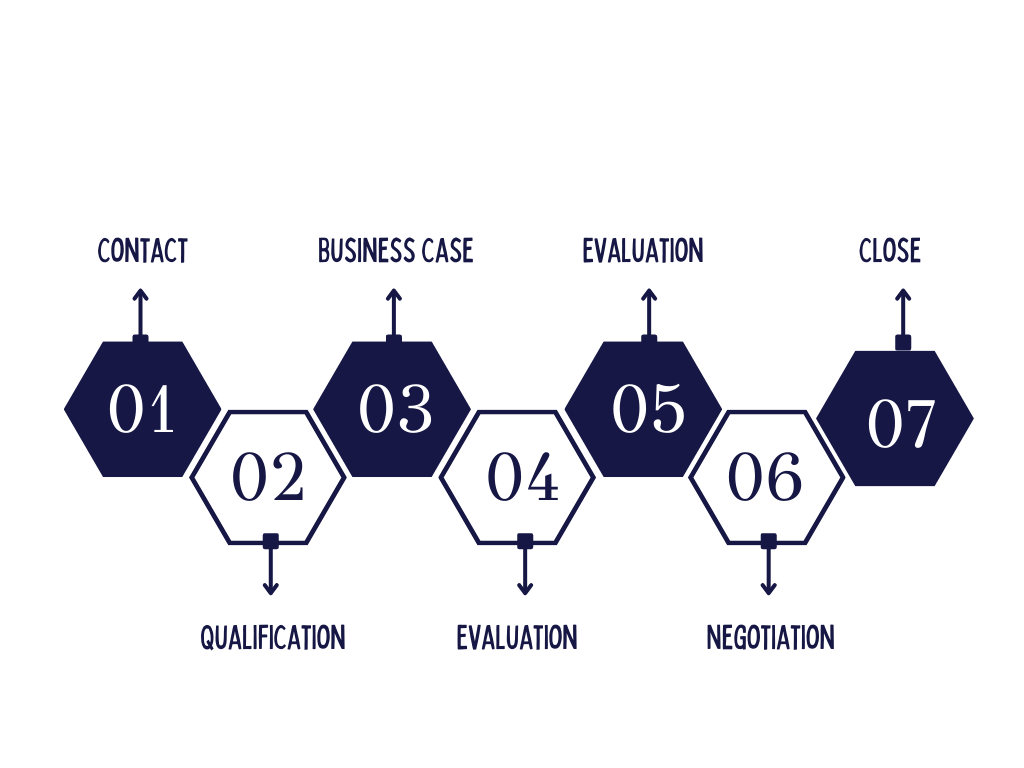
Sales Process Map Example

Target Audience
Developing your target audience and segmenting your GTM sales strategy is critical to success when selling to businesses. The first step is to define your target market. This includes understanding the needs and wants of your customers and determining which companies fall within your ideal customer profile. Once you have a good understanding of your target market, you can begin to segment it into specific groups that you can focus on reaching with your sales efforts. Your sales efforts should be in alignment with marketing. Your sales team should know what marketing messaging is being sent out to which audiences so your sales team can be focused on that same messaging to the same audience.
One way to segment your target market is by company size. You can target small, medium, or large businesses, or focus on a specific industry. Another way to segment is by the stage of the buying process that the company is in. You can target prospects who are researching their options, those who have already decided on a supplier, or those who are ready to buy. You can also target buyers or decision-makers within a company, or those who have the budget to purchase your product or service.
Once you've defined your target audience and segmented it into specific groups, you can begin developing joint marketing and sales strategies specifically for each group. Tailor your messaging and content to appeal to each group's needs and wants. Make sure your team is knowledgeable about each segment so they can personalize their interactions with potential customers.
By defining your target audience and developing tailored marketing and sales strategies for each group, you'll be better positioned for success when selling to businesses.
Sales Messaging
Sales messaging is the art of communicating the value of a product or service to potential customers. It involves highlighting the differentiators that make your product or service unique and explaining the outcomes that customers can expect to achieve by using it.
Value props are the features or benefits of a product or service that are most important to customers. Differentiators are the factors that make your product or service unique and appealing to buyers. Outcomes are the results that customers can expect to achieve by using your product or service.
The goal of sales messaging is to persuade potential customers to buy your product or service. It's essential to be clear, concise, and accurate in your communications, and to focus on the factors that are most important to buyers.
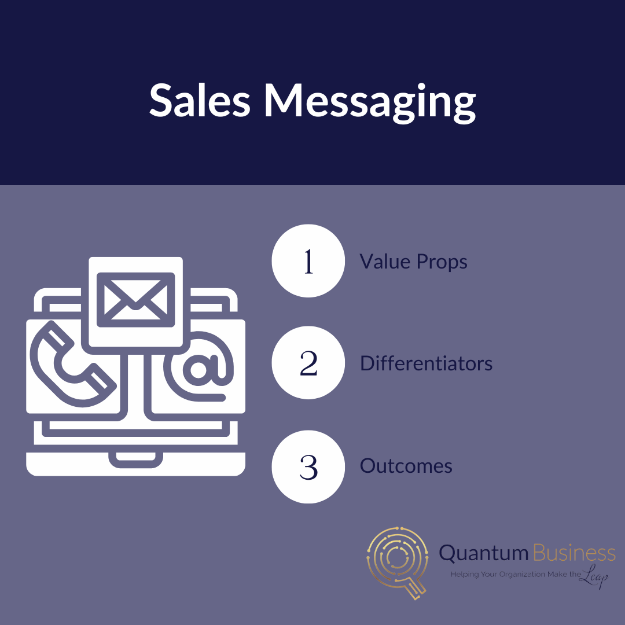
Your sales messaging should be consistent, regardless of the platform in which it is delivered. This could include in-person sales meetings, phone calls, voicemails, emails, text messages, etc. By being consistent, you will make it easier for customers to understand your product and what you are trying to sell them. It also makes your business seem more professional and organized.
You will find more information and guidance on scripts and messaging in Quantum’s Prospecting Playbook.
Lead Scoring
Lead scoring is a technique used by businesses to rank leads in order of their sales readiness. This technique uses a points-based system, where each point corresponds to an action or engagement that a lead has taken.
HubSpot's lead scoring tool is an easy way to implement lead scoring into your business. The tool allows you to add points to leads based on the actions they take on your website, such as filling out a contact form or subscribing to your blog. You can also assign points manually if you want to give more weight to certain actions.
The advantage of using HubSpot's lead scoring tool is that it integrates with the rest of your HubSpot account. This means that you can see how each individual lead is performing and how they rank against your other leads. You can also use the tool to create custom email workflows based on a lead's score.
Lead scoring is an important tool for businesses because it helps them prioritize their leads and focus their efforts on the ones that are most likely to convert into customers. It can also help you identify which marketing channels are generating the best leads.
One way to route high-quality leads to your top-performing account reps is to automate the interaction with lower-quality leads. This can be done by using a lead scoring system that ranks leads based on their quality and then automatically assigning them to the reps best suited to work with them. This will help you ensure that your best reps are working with the highest-quality leads, while also freeing up more of their time to focus on closing sales.
Customer Service Plan
Developing a customer service plan for your go to market strategy is essential for success. When creating your plan, be sure to consider the following:
- 1.Define your goals: What do you want your customer service process to achieve? Do you want to improve customer satisfaction rates? Reduce the number of complaints? Lower the cost of customer support? Once you know what you want to achieve, you can design a process that will help you reach those goals.
- 2.Establish standards: What are the minimum standards of service that you will provide to your customers? What are the expectations that you have for your team members? By setting clear standards, you can ensure that all customers receive the same level of service, no matter who they speak to.
- 3.Train your team members: Your team members are the backbone of your customer service process. Make sure that they are fully trained on how to handle customer inquiries and complaints. They should also be familiar with your company’s policies and procedures.
- 4.Manage expectations: It’s important to manage customer expectations from the beginning. Let them know what kind of response time they can expect, and what kind of assistance they can expect from your team members. This will help avoid any misunderstandings or disappointment later.
- 5.Use tools and technology: There are multiple tools and technologies that can help improve your customer service process. Automated systems can help reduce the amount of time it takes to handle customer inquiries, while chatbots can provide instant assistance to customers 24/7.
Step 3: Optimize
After a product has been launched, it is important to create the most efficient way to penetrate the market. This can be done by streamlining any antiquated processes or technology. Additionally, it is important to track key performance indicators to understand what works best. By doing this, a company can continue to improve their go to market strategy and maximize their success.
Ultimately, optimization will be guided by our KPIs, but will include the following:
- Building and managing lists
- Nurturing leads who haven’t yet committed
- Building workflows
- Pipeline Management
- Maximizing Free Billboard Space opportunities
- Content optimization

KPIs for Optimization
There is a reason Quantum requires all clients to start tracking standard KPIs and establishing baselines from the beginning of our engagement with you. Monitoring KPIs closely results in a more efficient process overall, as well as the ability to make quicker adjustments. This is because you can quickly identify areas that need improvement and make changes accordingly. Tracking KPIs can be especially helpful in sales and marketing. In these departments, things can change rapidly and it's important to be able to react quickly.
So, at this stage, what are some KPIs that businesses should track?
ICP Fit:
Businesses should track the percentage of data filled with the correct types of prospects, clients, and contacts. This allows you to measure how successful you are at acquiring new customers and maintaining relationships with past customers. In addition, it allows you to make necessary adjustments to your marketing and sales strategies to improve these percentages.
Tracking how many of your current customers match your ICP profile allows you to measure how successful you are at acquiring new customers and maintaining relationships with past customers.
Conversion Rates in the Pipeline:
These KPI's measure the percentage of people who take a desired action after interacting with your brand at different stages. This could be anything from signing up for a newsletter to making a purchase. Monitoring your conversion rate is important because it helps you determine whether your marketing efforts, lead gen, sales, or client success are effective. If you're not seeing the results you want, you can make necessary changes to improve your conversion rate in each area.
Sales and marketing are two essential functions of any business. The purpose of sales is to identify and convert potential customers into paying customers. Marketing's job is to create awareness of the company and its products or services, as well as generate interest in those products or services. Both sales and marketing are important, and both should be tracked closely to ensure success.
Customer acquisition costs:
This KPI measures how much it costs you to acquire a new customer. This includes things like advertising costs, employee salaries, etc. It's important to track this KPI because it helps you determine whether your marketing efforts are profitable. If your customer acquisition costs are too high, you're likely losing money on each new customer you acquire. Whatever the case may be, it's important to know what's working and what's not so that you can make the most of your sales and marketing efforts.
The purpose of sales and marketing is to generate revenue for the company. This revenue can be generated in two ways: by converting potential customers into paying customers, or by increasing the average sale price. To generate as much revenue as possible, it's important to track the return on investment for sales and marketing efforts.
ROI is a measure of how successful a particular activity is in terms of generating revenue. It's calculated by dividing the amount of revenue generated by that activity by the amount of money spent on that activity. This tells you how much money you're making for every dollar you spend on that activity.
Churn rate:
This KPI measures the percentage of customers who cancel or do not renew their subscription with your company within a certain period of time. Churn rates can be high for many reasons, such as poor customer service or a lack of features/benefits. Tracking this KPI is important because it helps you determine whether your retention efforts are effective. If your churn rate is too high, it's an indication that something needs to change within your company.
One way to ensure client success is by operating efficiently. This means minimizing waste and maximizing productivity. There are many ways to achieve operational efficiencies, such as streamlining processes, automating tasks, and using the right tools. By implementing these strategies, you can improve your productivity and reduce the amount of time and money spent on tasks that don't add value.
The three examples above are just a few of the most important KPIs that businesses should track as you focus on optimization.
Here are some KPI's to get you started:
- ICP Fit Ratio
- Conversion rates at each stage
- Customer acquisition costs
- ROI
- Churn rate
- Productivity
- Efficiency
- Revenue generated by sales and marketing efforts
- Average sale price
- Number of potential customers converted into paying customers
- Lifetime Value of a Client
- ICP Fit Ratio
- Referrals by Current Clients
- Revenue Attribution
- Sales Velocity
Building and Managing Lists
Sales teams need to be diligent in tracking the effectiveness of their lists and optimizing them as needed to generate results. There are several factors to consider when assessing list performance, such as how well the leads match the criteria for the target market, how many of the leads are contacted, and how many leads convert to sales. Sales teams need to have a solid understanding of these factors to make informed decisions about list optimization. Sales team leaders should be closely monitoring KPIs to identify list effectiveness.
One common method for improving list performance is by culling or pruning inactive leads from the list. Inactive leads are those who have not been contacted recently or who have not resulted in a sale.
Another method for improving list performance is by adding new leads. The most efficient way to do this is to harvest them through a tool like ZoomInfo that is already integrated with your CRM. The key is to make sure that the new leads match the criteria for the target market.
List performance can also be improved by segmenting the list into smaller groups based on factors such as demographics, interests, or buying behavior. This allows sales teams to focus their efforts on specific groups of leads and tailor their messaging accordingly. It also allows them to track performance more closely and adjust as needed.
Segment lists by the following:
- Buyer Personas
- Industry verticals
- Products or services for current customers
- Renewal periods for current customers
- Competitor data
- Engagement activities on your website or with content offers
Nurturing Leads Who Haven’t Converted Yet
After you've identified and nurtured your leads, it's important to continue to follow up with them even if they haven't yet converted to a closed deal. This is where lead nurturing comes in. By sending targeted content and communications to leads who haven't closed yet, you can encourage them to become customers.
One way to nurture leads is to send them relevant content that's tailored to their needs. When you send the right content, you can help them understand the value of your product or service and how it can benefit them. You can also help them see how your company is different from your competitors.
It's also important to stay in touch with leads through regular communications. This can help keep them top-of-mind and remind them of the benefits of doing business with you. You can send emails, make phone calls, or even send physical mailers.
By following up with leads and providing them with relevant information, you can increase the likelihood that they'll eventually convert into customers.
Building Workflows
Workflows are an important part of HubSpot. They allow you to automate your marketing and sales processes, saving you time and money. There are a variety of workflows you can build in HubSpot, each with its own benefits.
A basic workflow might include a series of tasks that need to be completed in order to achieve a goal. For example, you could create a workflow that sends an email notification to your team when a new lead is generated. This notification would remind them to follow up with the lead and convert them into a customer.
Another common type of workflow is a lead nurturing campaign. This type of workflow is designed to move leads through the sales funnel by providing them with targeted content at each stage of the process. For example, you might send a lead an introductory email followed by a series of additional emails that provide more information about your product or service.
Workflows can also be used to automate repetitive tasks. For example, you could create a workflow that automatically updates contact information when it changes on your website. This would save you time and ensure that your contact information is always up to date.
The benefits of using workflows vary depending on the type of workflow you create. However, all workflows have the potential to save you time and money while improving your marketing and sales results.
7 Workflows to Implement Today Based On Trigger Events:
- 1.Call Outcome Trigger
- 2.Deal Stage Change Trigger
- 3.Lead Status Change Trigger
- 4.List Enrollment Trigger
- 5.Engagement Level Trigger
- 6.Lead Score Trigger
- 7.Time Based Trigger
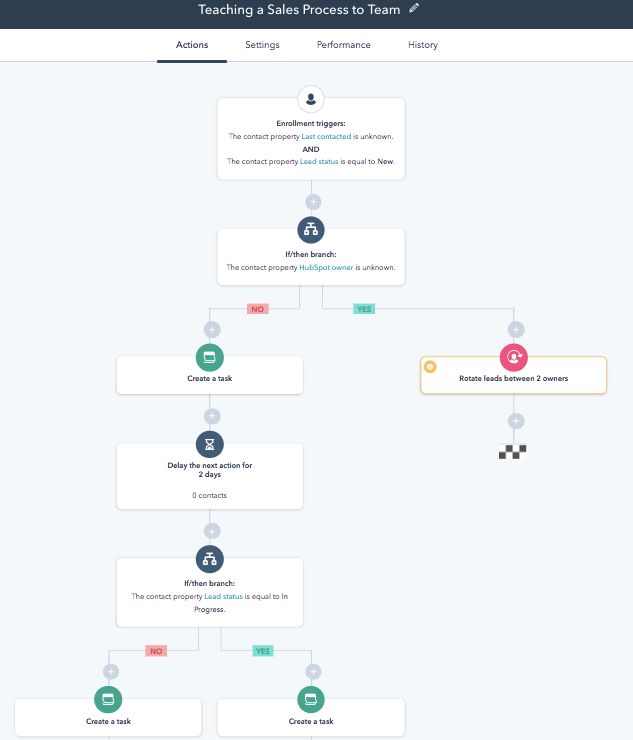
Pipeline Management
Pipeline management is a critical element of any successful GTM strategy. By properly managing your pipeline, you can ensure that you are always focusing on the most promising leads, and that you are not wasting time on deals that are unlikely to close.
Pipeline management also enables you to track your progress towards your goals. You can use pipeline data to determine how many new customers you need to add each month to meet your targets, and then adjust your strategy accordingly.
The bottom line is that if you want to succeed in today's competitive marketplace, you need to have a well-managed pipeline.
Pipeline Management in HubSpot
Pipeline management is one of the most important features of HubSpot. It allows you to track your leads through the sales process and measure the effectiveness of your efforts. With pipeline management, you can see at a glance how close each lead is to becoming a customer.
For example, you could create a workflow that sends an automated email to contacts who have been added to your sales pipeline but haven't been contacted within a certain number of days. This workflow could be triggered automatically when a contact is added to the sales pipeline, or it could be started manually by a team member. Another example would be to create a "thank you" workflow that is triggered when a contact is marked as "converted." This workflow could send an automated email or call thanking the customer for their business. You could have additional steps within the workflow such as automated gifts to be sent to new customers, notifications to your fulfillment team, etc.
Sales pipelines are an important part of any business but managing multiple sales pipelines can be a daunting task. In addition to transactional and recurring revenue, there are other types of revenue that may need to be tracked and managed. For example, subscription-based businesses may have different sales cycles for new customers and renewing customers.
To effectively manage multiple sales pipelines in HubSpot, it is important to understand the different types of revenue and how they relate to each other. It is also important to track each sale as it progresses through the sales cycle, from initial contact to close. This will help you identify any potential bottlenecks in the process and make necessary adjustments.
Finally, it is important to have a process for tracking and reporting on the progress of each sales pipeline. This information can be used to make decisions about where to allocate resources and which sales channels are most effective.


Maximizing Free Billboard Space
It's no secret that the best way to get in front of leads and customers is through visibility. You want them to see your name and your products and services (including your full product lineup) as often as possible so that you become top of mind for all the products and services you provide. You also want to make it as easy for them as possible. There are many free mechanisms available to you to achieve this visibility.
Some of these free mechanisms include:
- Creating a strong social media presence, with high-quality, relevant content
- Participating in industry events and tradeshows
- Developing thought-leader content (blog posts, white papers, etc.), which you can then promote through social media and email marketing
- Creating a company website that is easy to navigate and showcases your products and services prominently
- Developing a strong search engine optimization (SEO) strategy for your website
Here are some very easy-to-implement examples of how you can maximize visibility through the utilization of your Free Billboard Space.
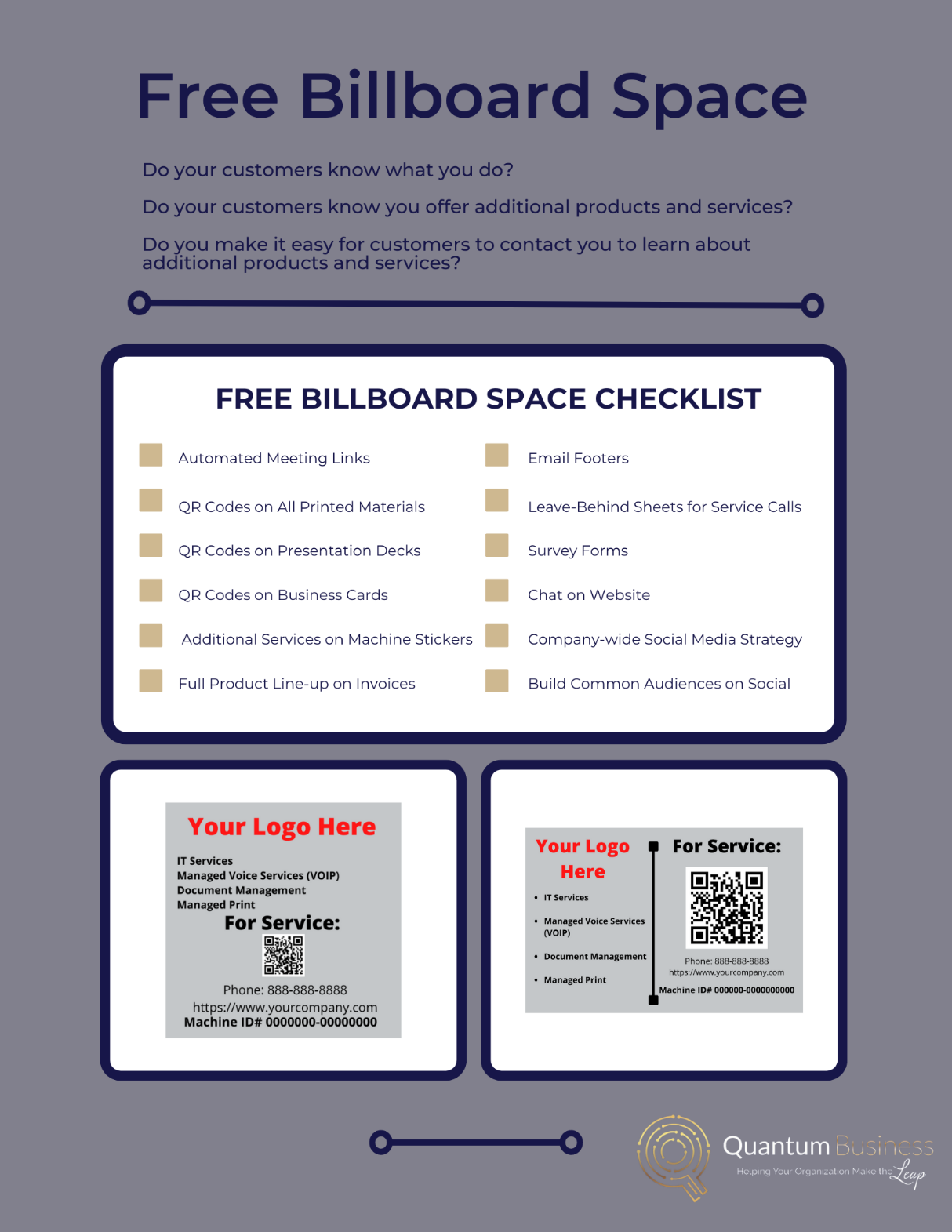
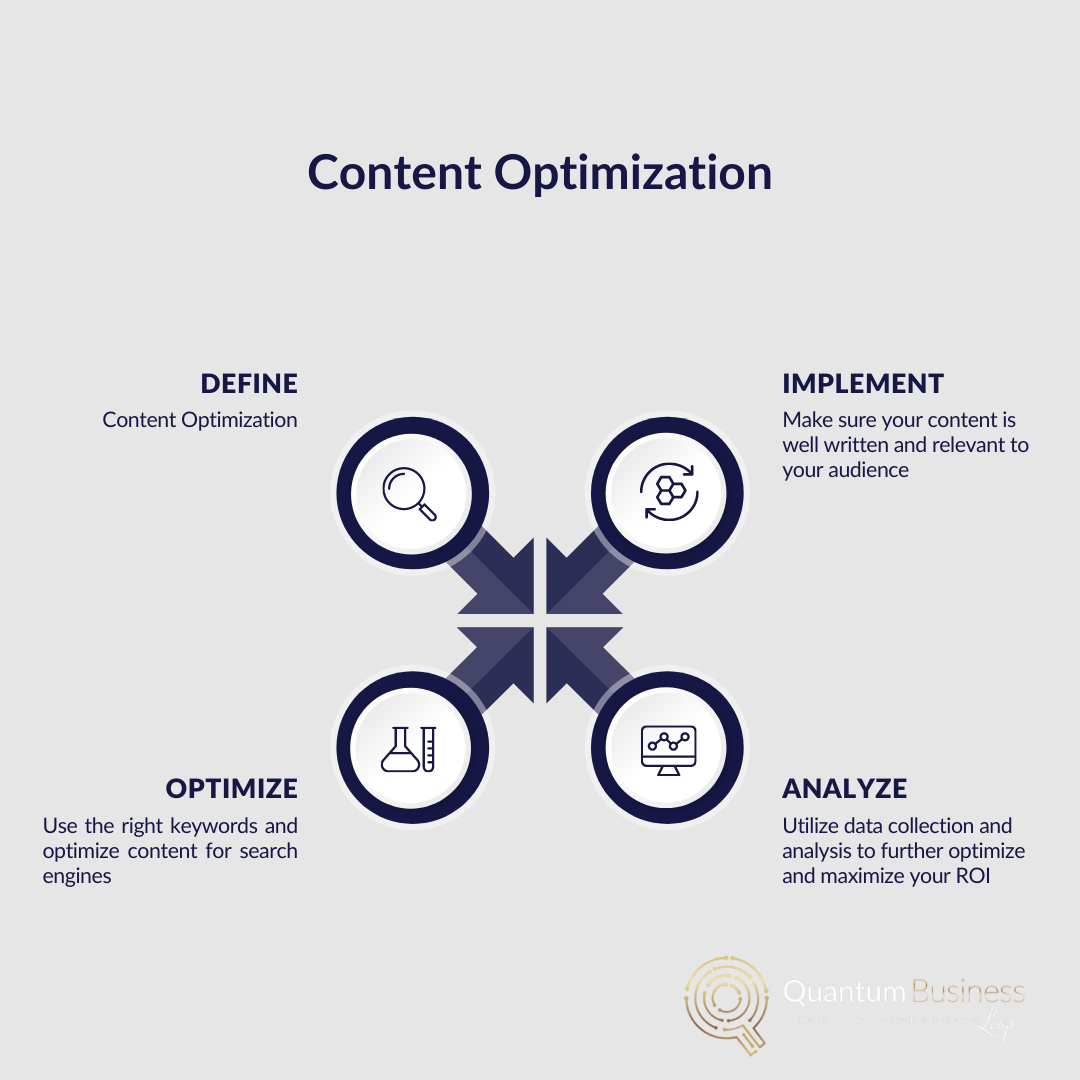
Content Optimization
There is no question that content optimization is important for your GTM strategy. However, what exactly does that mean? And more importantly, how can you ensure that your content is as effective as possible?
In a nutshell, content optimization means making sure your content is effective in reaching your target audience and achieving your business goals. This includes everything from making sure your content is well-written and relevant to your audience, to using the right keywords and optimizing it for search engines. This involves improving the visibility and ranking of your website content so that it appears higher on search engine results pages (SERPs). When potential customers are searching for information related to your products or services, you want your website to be one of the first results they see.
There are a number of ways to optimize your website content for better search engine visibility. One of the most important is to make sure your content is keyword rich. This means using relevant keywords throughout your text, including in the title, in the body, and in the tags. You can also use keyword variations and synonyms to help improve your ranking.
There are a number of different factors you need to consider when optimizing your content, including:
- Keywords: Choose the right keywords for your content, and make sure you use them throughout the text.
- Title: The title of your article is one of the most important factors for ranking in SERPs. Make sure it accurately reflects the topic of your article and includes some of the key keywords.
- Meta Description: The meta description is the short snippet of text that appears under the title in SERPs. It’s important to make sure this accurately reflects the contents of your article and includes some of the key keywords.
- Images: Include images in your articles whenever possible and be sure to optimize them with keyword-rich alt text.
- Headings and Subheadings: Use heading tags (H1, H2, etc.) to break up your article into easy-to-read sections and include some of the target keywords in those headings.
- Links: Link to other authoritative sites whenever possible and include relevant keywords in those links.
Optimizing your content can be a lot of work, but it’s worth it if you want to see better results from your marketing efforts. By following these tips and using the right tools and resources, you can create content that’s not only effective but also profitable for your business.

Step 4: Automate
Accelerate your time and efforts by streamlining, automating, and scaling as many parts of the GTM strategy as possible, so you can stay focused on what matters most: delighting customers through every stage in their journey!
70% of what sellers do today can be AUTOMATED (Source: Tech Powered Sales)
“The future of B2B selling is when buyer sentiment meets seller relevance with human engagement empowered by technology that melts away as humans focus on high-value interactions.” – Tony Hughes, Technology Powered Sales
Sales teams can now focus on building relationships and providing value to buyers rather than on administrative tasks. Automation allows sales teams to spend their time where they can provide the most value and create the best customer experience. In addition, automation can help sales teams track their progress and measure their impact on the bottom line. This data can help sales managers make better decisions about how to allocate resources and improve results.
At this stage, you should be checking for any gaps. What can be automated that is not yet automated?
Key elements of your GTM strategy that should be automated include:
- Target
- Data Enrichment
- Lead identification
- Lead lists based on the target audience and intent data
- Loading leads and lead lists into your CRM and dialer
- Attract
- Content
- Email campaigns
- Social media outreach
- Scheduling of social media posts
- Lead capture forms
- Lead prequalification and lead scoring
- Lead routing Dialing
- Texts and voicemail drops
- Nurture
- Scheduling
- Meeting reminders
- Meeting recordings and transcripts
- Forms
- Video messages
- Convert
- Pipeline management
- Quotes & Payment links
- Wow
- Ongoing Nurturing Campaigns
- Customer Appreciation/Automated Gifting
- Tasks/Reminders for Follow-up
- Other
- Workflows
- KPIs/Dashboards & Reporting
- Internal notifications
There are a variety of tools available to accomplish most of these automations. We will highlight and outline some of Quantum’s recommended tools and resources as examples for how these automations can work.
Target
ZoomInfo is a powerful business intelligence tool that provides users with in-depth data on potential customers and partners. The platform offers users the ability to research companies, individuals, and contacts, as well as track key updates and news related to their industry. Additionally, ZoomInfo offers a variety of search and filtering options to help users quickly find the information they need. With its robust search capabilities and ability to track updates and news, ZoomInfo is an excellent tool for keeping up with the latest industry trends.
ZoomInfo has many integrations available, including integration with HubSpot. You can utilize ZoomInfo to enrich your contact data in your CRM, as well as to identify new leads who meet your target criteria, who are in a certain industry, or who are showing intent for your products or services. By using ZoomInfo's powerful search capabilities and integrations with other platforms, you can get the most out of your business intelligence needs.
If you are using ZoomInfo and HubSpot, you can set up workflows to add leads who meet specific criteria into lists for sales and marketing outreach. These lists can also be fed directly into a dialer integrated with HubSpot such as ConnectandSell or Kixie.
Attract
Content:
Sales and marketing content is key to any business. It can be the difference between success and failure. Jasper is a great tool for creating this type of content. With Jasper, you can create dynamic and engaging content that will capture your audience's attention. You can also use Jasper to create reports and other documents that will help you sell your products or services.
Email Campaigns:
Email marketing is an effective way to reach out to customers and keep them updated on your products or services. However, manually creating and sending out individual email campaigns can be time-consuming. HubSpot offers a tool that allows you to automate your email campaigns, making the process faster and easier. With HubSpot's automation tool, you can create a series of emails that will be sent out automatically at predetermined intervals. This tool also allows you to track the success of your campaigns, so you can gauge the effectiveness of your efforts and make necessary adjustments. Automating your email campaigns with HubSpot is a great way to save time and improve your marketing efforts.
Social Media Outreach:
Kennected is an example of a social media outreach tool that can assist you with growing your social media following and expanding your reach. It allows you to connect with other users on various platforms, including Twitter, LinkedIn, and Facebook. This tool makes it easy to find and follow other users who share your interests, and it also provides insights into how well your posts are performing. By using Kennected, you can grow your social media presence and reach a larger audience.
Scheduling Social Media Posts:
Hubspot's social media tool can help you schedule your posts on various platforms. You can create a calendar of content to post, and the tool will automatically publish it for you. This can help you ensure that your social media accounts are regularly updated with fresh content.
Lead Capture Forms:
HubSpot lead capture forms are used to collect information from website visitors. The forms can be customized to collect different types of information, such as name, email address, company name, and phone number. Once the form is filled out, the information is automatically added to the visitor's contact record in HubSpot. Typically, you will give something in exchange for the completion of a lead capture form. Some examples of what you could give in exchange for someone completing a lead capture form include:
-A free consultation call
-A free e-book or whitepaper
-A free trial of your product or service
Lead Prequalification & Lead Scoring:
There are a few ways to automate lead prequalification. One way is to have potential leads fill out a form on your website that asks them a few questions about their business. This can help you determine if a lead is worth pursuing further. Another way to automat lead prequalification is to use a tool like HubSpot's Lead Qualification Tool. This tool will automatically score leads based on their engagement with your content and other factors, and it will then assign them a qualification rating. This can help you determine which leads to pursue and which ones to ignore.
Lead Routing:
Routing leads is a critical part of any inbound marketing strategy. By automating the process, you can ensure that leads are routed to the appropriate member of your sales team as quickly as possible. When a new lead comes in, HubSpot can automatically route it to the appropriate sales representative based on predefined rules. This saves time and ensures that leads are always routed to the right person.
Dialing:
A dialer such as Kixie can automate calling by allowing you to input a list of phone numbers and then provide a timed sequence of calls. This can be helpful for businesses that want to make a large number of calls in a short period of time. The dialer can also be set up to leave voicemails or connect to an answering service.
Since its inception, ConnectAndSell has revolutionized the process of outbound dialing. By streamlining the process and providing an easy-to-use interface, ConnectAndSell has made it easier than ever for sales reps to make connections and sell their products or services. This has led to a dramatic increase in sales productivity and overall efficiency. Additionally, ConnectAndSell makes it easy to identify qualified leads and track the success of each campaign. By providing detailed analytics and reporting, ConnectAndSell helps sales reps optimize their efforts and achieve better results.
Automated Texts & Voicemail Drops
There are a number of benefits to using a tool like Drop Cowboy for automated texts and voicemail drops. Perhaps the most obvious benefit is that it can save you a lot of time and hassle. With Drop Cowboy, you can create and send automated messages in just a few minutes, without having to worry about formatting or coding. Another big benefit is that automated messages are more likely to be read and acted on than traditional messages. Automated messages are quick and easy to understand, and they don't require the recipient to take any special action to view them. This makes them perfect for busy people who might not have time to read a long email or listen to a long voicemail.
Nurture
Scheduling:
Automated scheduling links save time. With a few clicks, you can have your entire schedule filled with confirmed appointments. Automated scheduling links also make it easy to keep track of your appointments. You can see immediately when you are booked and when you are free. This can help you to better manage your time. Automated scheduling links can help to ensure that your appointments are accurate. Appointments that are booked through an automated system are less likely to be canceled or changed.
Meeting Reminders:
Automated meeting reminders keep leads and customers updated on upcoming appointments. This can be done through text messages, emails, or phone calls. Automated meeting reminders help to avoid missed appointments and ensure that all parties are prepared for the meeting.
Meeting Recordings & Transcripts:
One of the benefits of using automation to record meetings and get transcripts is that it can help to improve communication and collaboration. By having a transcript of a meeting, everyone can be on the same page, and any misunderstandings can be cleared up quickly. Automated transcription can also help to identify key points and action items from meetings so that everyone is on the same page with regard to what needs to be done. This can save time and ensure that tasks are not missed. Additionally, automated transcription can be used to create meeting minutes, which can be shared with all meeting attendees. This can help to keep everyone updated on what was discussed during the meeting.
Forms:
HubSpot forms are a great way to collect customer information. You can use them to create surveys, questionnaires, or even just simple contact forms. Forms are easy to create, and you can customize them to match your website's design. You can also create forms for your sales team to use for internal purposes such as to collect specific information in a discovery call or during a quarterly business review.
Video:
Video is a tool that should be leveraged by sales teams. One-to-one videos sent by email or text or even on social media platforms do not have to be professionally produced. You can utilize a tool like Vidyard or just record a simple message on your phone. Here are a few stats regarding video messages.
- 58% of viewers watch a business-related video all the way through if it’s less than 60 seconds long
- Over 70% of sales pros report that video email performs better than text-based email
- More than 70% of sales pros who leverage video report that it has increased response rates
- 56% of sales pros report that video has helped reduce the need for lengthy emails and chat messages
- 48% of sales pros say custom-recorded videos shorten their deal cycle
Convert
Pipeline Management:
Automation can help you manage your sales pipeline more effectively by automating the process of adding new opportunities, updating stages, and sending notifications. This can help you save time and keep your sales pipeline up to date. Additionally, automation can help you track your progress toward your goals and identify areas where you need to improve.
Quotes & Payment Links:
HubSpot payments offer a number of advantages for both quotes and payment links. They are a secure payment platform that is PCI compliant, meaning that your customer's data is safe and secure. HubSpot also offers a great user experience, with an easy-to-use interface and a wide range of features. Payments can be made quickly and easily through HubSpot, and you can track payments and transactions through the platform's reporting tools.
With HubSpot Payments, you can:
- Pay with a credit card or bank account
- Set up automatic payments
- Get monthly invoices and payment history
- View and download past invoices
Wow
Ongoing Nurturing Campaigns
An ongoing nurturing campaign is a marketing strategy that is implemented continuously in order to keep leads warm and customers engaged, increasing the chances of conversion and retention. There are many ways to automate an ongoing nurturing campaign with HubSpot, but some of the most common methods include setting up automated email sequences and using marketing automation tools to segment leads based on their engagement levels.
Customer Appreciation & Automated Gifting:
Automated gifting integration between HubSpot and Sendoso can automate the process of sending and tracking gifts, saving time and resources. It can help businesses build better relationships with their clients by providing a more personal touch.
Tasks & Follow up
Task management software, such as HubSpot, can help businesses keep track of tasks that need to be completed at key times, such as follow-ups after a purchase or event. This can help improve customer satisfaction by ensuring that all tasks related to customer service are completed in a timely manner. Additionally, task management software can help businesses track customer interactions and history, which can help when responding to customer inquiries or complaints.
Other
Workflows:
Workflows will be utilized throughout every stage of the GTM funnel for a wide variety of tasks and activities. One of the primary benefits of using HubSpot is the ability to automate activities. This can be done through workflows, which are a series of rules that define how an action should be taken based on a set of conditions. Workflows can be used to automate tasks, including:
- Sending emails
- Posting to social media
- Adding or removing people from lists
- Notifying someone when a task is completed
- Each of these tasks can be automated using workflows, saving you time and effort. In addition, workflows can also be used to trigger other workflows, creating a cascade of automated tasks that can help you more efficiently manage your marketing activities.
KPIs/Dashboards
Baselining and tracking KPIs are reinforced at every step in your engagement with Quantum. Depending on your tech stack, we may begin with tracking your KPIs on a spreadsheet, but the goal will be to transition these to an automated dashboard.
Monitoring your KPIs is essential to understanding how your business is performing and making necessary changes to ensure success. While you can track KPIs manually, using an automated dashboard such as HubSpot can make the process simpler and more efficient.
There are several advantages to using HubSpot to track your KPIs. First, HubSpot's automated dashboard makes it easy to quickly see how your business is performing across all key metrics. This allows you to easily identify areas of success and areas in need of improvement. Additionally, HubSpot's integrations with other tools, such as Google Analytics, Salesforce, and social media platforms, allow you to get a more holistic view of your business performance. This can help you identify correlations between different aspects of your business and make decisions accordingly.
Overall, using an automated dashboard such as HubSpot to track your KPIs is an effective way to ensure that you are constantly monitoring your business performance and taking action where necessary.
Internal Notifications:
Internal team communication is key to a smooth sales order process. Ensuring that every member of your team knows what to do once an order comes through and using automation to move tasks forward are two ways to help improve communication.
HubSpot workflows can be used to help keep everyone on the same page. For example, you can create a workflow that sends an email notification to the next person in the sales order process when a new order is received. This helps ensure that no one falls through the cracks and that tasks are moving forward as they should.
There may be gaps in your sales order process, but by using HubSpot's automation tools, you can help fill them. Having visibility into the entire order process is another way to improve communication and help ensure that orders are being handled efficiently.
Step 5: Execute & Improve
Make sure you are constantly improving, adjusting, and enhancing your GTM strategy. You can do this by regularly testing new ideas, making changes to your existing setup, and studying your data to see what is and isn’t working. This will help you fine-tune your strategy and get the most out of your GTM implementation.
You should know:
- Total # of leads generated
- Lead conversions through each stage of the funnel
- Where leads drop out if they don’t convert to the next stage of the funnel
You should focus on:
- Shortening the conversion time between each stage of the funnel
- Speed up the process of lead capture. Make sure your form is easy to fill out and only asks for the most essential information.
- Follow up quickly with potential leads. Send them an automated email or call them within minutes of them expressing interest.
- Use lead scoring to determine who is most likely to convert and focus your efforts on those individuals.
- Keep your messaging clear and concise. Avoid bombarding leads with too much information at once.
- Use landing pages to funnel leads toward conversion. Make it easy for them to learn more about your product or service and take the next step.
- Identifying and finding solutions to remove common objections. Some ideas for identifying and finding solutions to remove common objections are:
- Offering a trial period or free sample
- Making it easy to cancel or change subscription plans
- Having a clear and concise refund policy
- Making it easy to contact customer service with questions or concerns
CAC & ROI
Calculating your customer acquisition cost (CAC) is important to track and measure the success of your marketing campaigns. To calculate your CAC, you first need to know your total marketing expenses for a specific time period. This includes all marketing expenses such as advertising, salaries for sales staff, and any other costs associated with acquiring new customers. Divide this number by the number of new customers acquired in the same time period. This will give you your CAC.
Return on investment (ROI) is a performance measure used to evaluate the efficiency of an investment or to compare the efficiency of a number of different investments. To track ROI, you need to compare the revenue generated by your new customers to the customer acquisition cost. If the revenue generated is greater than the customer acquisition cost, then you have achieved a positive ROI and the campaign was successful. If the revenue generated is less than the customer acquisition cost, then the campaign was not successful, and you may need to rethink your strategy. By analyzing and optimizing your customer acquisition cost, you can improve the effectiveness of your marketing campaigns and achieve better results.
A/B Testing
A/B testing is a process of comparing two versions of a web page or email to see which one performs better. It can be used to determine the best design for a web page, the most effective wording for a call to action, or the most persuasive offer.
A/B testing is important to your GTM strategy because it can help you determine which version of your website or app is more effective. This information can help you make decisions about how to improve your website or app and increase your sales or conversions. Utilize A/B testing for email performance.
Maintain Email Health
Email health can be maintained by taking a few simple steps including using a secondary domain and a tool like NeverBounce. A secondary domain can be used to create a separate email address for important or sensitive communications. This can help to protect the main email address from spam and other types of abuse. A tool like NeverBounce can be used to verify the validity of email addresses before messages are sent. This can help to prevent messages from being sent to invalid addresses and help to keep the email list healthy.
Manage Sales & Marketing Alignment
Sales and marketing alignment is key. Achieving alignment means that both teams are working together towards the same goal, and that they are using the same strategy and tactics. This can be difficult to achieve, because the two teams often have different goals and objectives. The two teams need to communicate frequently and meet regularly to make sure that everyone is on track and staying aligned. Make sure that both teams are using the same strategy and tactics, so that there is no confusion about what they are trying to achieve.
Retain & WOW Your Customers
Studies have shown that it can cost up to five times more to attract a new customer than to keep an existing one. To ensure you are doing everything possible to keep your customers coming back, try implementing some or all of the following tips:
- Show appreciation - Thank your customers for their business and let them know you appreciate their loyalty. This can be done through calls, emails, handwritten notes, personal visits, customer appreciation events, gifts, etc.
- Make it easy for them to do business with you - Make sure your website is easy to navigate, your products are easy to find, and your checkout process is quick and easy.
- Offer incentives - Give your customers exclusive discounts, free shipping, or other special offers.
- Keep your promises - Deliver on the promises you make to your customers. If you say you're going to ship something within a certain timeframe, make sure it ships on time. If there are any delays, be sure to let your customers know ASAP.
- Stay in touch – Utilize nurturing campaigns and keep your customers updated on new products, special offers and upcoming events. Let them know how much you appreciate their business and why they should continue doing business with you.
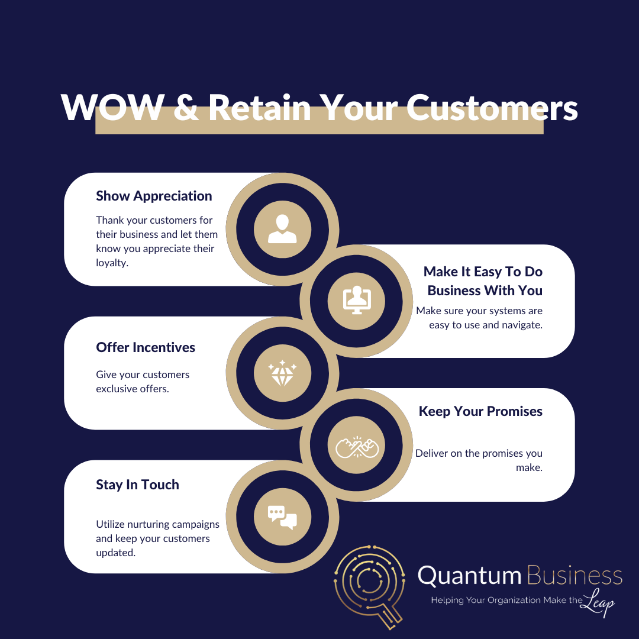
Renewals, Cross-Sell, Upsell & Referrals
When it comes to renewals, cross-selling, upselling, and referrals, it's important to think about how you can tap into your existing customer base. After all, they're already familiar with your product or service and are likely more likely to buy from you again than someone who is completely new to your company. Here are a few ideas to get you started:
For renewals, consider sending out an email or letter reminding customers of the benefits of staying with your company. You could also include a special offer or discount for those who renew their subscription or contract.
For cross-selling, try creating targeted lists of customers who might be interested in additional products or services that you offer. Utilize Free Billboard Space and nurturing campaigns to educate them on your other offerings. Send them personalized offers or information about what you have to offer.
For upselling, consider offering customers a higher tier of service or a premium version of your product at a slightly higher price. This can be a great way to increase your profits while still providing value to your customers.
And finally, for referrals, don’t forget to ask for the referral. Make it easy for customers to refer their contacts to your company by providing them with special offers or discounts for doing so. You can also create a rewards, affiliate, or partner program that gives customers extra points or financial incentives for referring others. If you do elect to implement this kind of program, you need to make sure you promote it on your website and through other communication channels with your customers. You also need to make sure you have appropriate tracking in place to monitor which leads come from which sources so that you can properly compensate the referring party.
Refine As Needed
Be flexible. In any business, there are always areas that can be improved. This is especially true for marketing, where new techniques and strategies are constantly emerging. A successful GTM strategy requires constant refinement to maintain performance. If your strategy starts to lag, make the necessary adjustments to get it back on track. Evaluate what is working and what needs improvement, then act on that information. There may be changes you need to make to your marketing mix, your targeting, or your execution. Keep an open mind and be prepared to adapt as needed to achieve the best results. By being proactive and responsive, you can keep your GTM strategy running smoothly and achieve the best results possible.
REMEBER THIS IS A LIVE DOCUMENT AND IS BEING UPDATED REGULARLY! You might want to add this page to your bookmarks.
Let Quantum Help You
Make the leap!
https://www.thequantumleap.business
Scan the code below for a consultation with Shawn:

